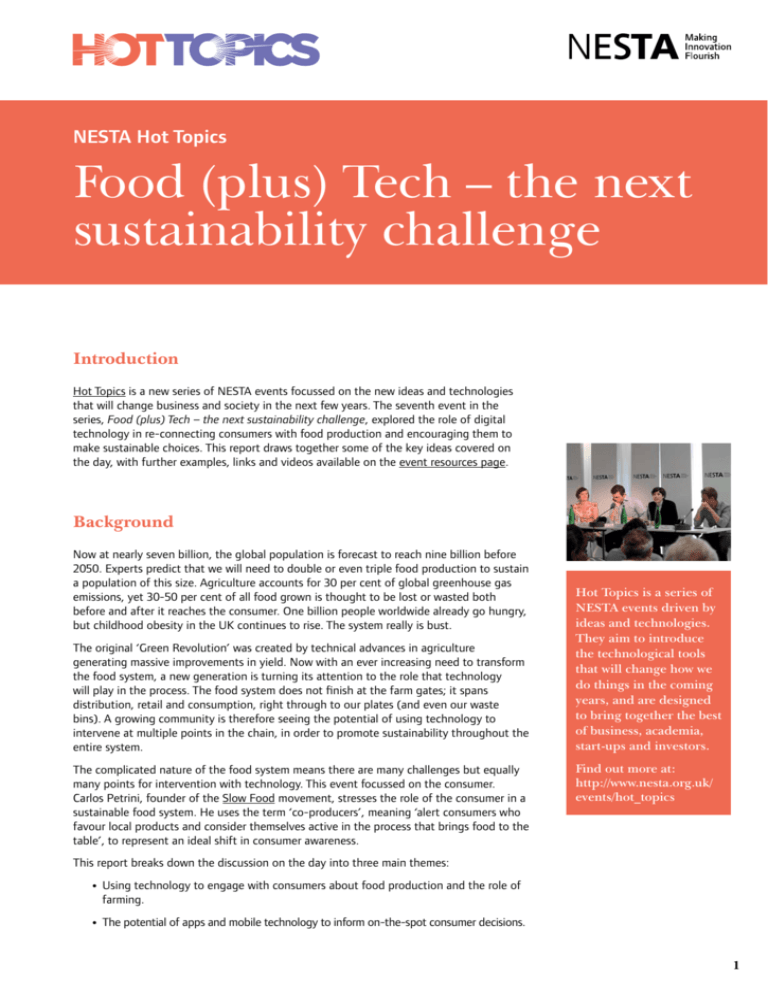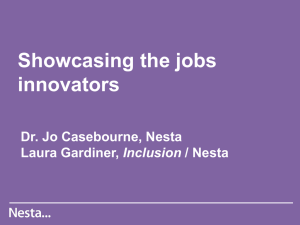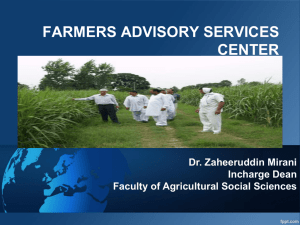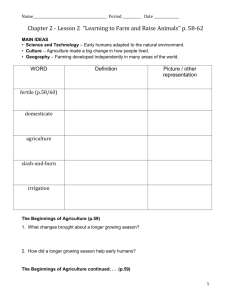Food (plus) Tech – the next sustainability challenge
advertisement

NESTA Hot Topics Food (plus) Tech – the next sustainability challenge Introduction Hot Topics is a new series of NESTA events focussed on the new ideas and technologies that will change business and society in the next few years. The seventh event in the series, Food (plus) Tech – the next sustainability challenge, explored the role of digital technology in re-connecting consumers with food production and encouraging them to make sustainable choices. This report draws together some of the key ideas covered on the day, with further examples, links and videos available on the event resources page. Background Now at nearly seven billion, the global population is forecast to reach nine billion before 2050. Experts predict that we will need to double or even triple food production to sustain a population of this size. Agriculture accounts for 30 per cent of global greenhouse gas emissions, yet 30-50 per cent of all food grown is thought to be lost or wasted both before and after it reaches the consumer. One billion people worldwide already go hungry, but childhood obesity in the UK continues to rise. The system really is bust. The original ‘Green Revolution’ was created by technical advances in agriculture generating massive improvements in yield. Now with an ever increasing need to transform the food system, a new generation is turning its attention to the role that technology will play in the process. The food system does not finish at the farm gates; it spans distribution, retail and consumption, right through to our plates (and even our waste bins). A growing community is therefore seeing the potential of using technology to intervene at multiple points in the chain, in order to promote sustainability throughout the entire system. The complicated nature of the food system means there are many challenges but equally many points for intervention with technology. This event focussed on the consumer. Carlos Petrini, founder of the Slow Food movement, stresses the role of the consumer in a sustainable food system. He uses the term ‘co-producers’, meaning ‘alert consumers who favour local products and consider themselves active in the process that brings food to the table’, to represent an ideal shift in consumer awareness. Hot Topics is a series of NESTA events driven by ideas and technologies. They aim to introduce the technological tools that will change how we do things in the coming years, and are designed to bring together the best of business, academia, start-ups and investors. Find out more at: http://www.nesta.org.uk/ events/hot_topics This report breaks down the discussion on the day into three main themes: •Using technology to engage with consumers about food production and the role of farming. •The potential of apps and mobile technology to inform on-the-spot consumer decisions. 1 •The role of convenience and its influence on behaviour change. For more information about current technology trends in agriculture, see the box at the end of this report on ‘The future of farming’. The event The Hot Topics event, Food (plus) Tech – the next sustainability challenge brought together a diverse group to discuss how information technology can be used help us make better choices about consumption and connect with those who produce food. Sharing their experiences on the panel were three UK entrepreneurs currently working to ‘disrupt’ the food system; Louise Campbell of Foodnation Ventures Ltd, creator of an iPhone app for discovering sources of local food and winner of the Ordnance Survey GeoVation challenge ‘How can Britain feed itself’; Jon Alexander of MyFarm, a National Trust experiment in letting 10,000 people run a British farm; and Arthur Potts Dawson, a chef and social entrepreneur who set up The People’s Supermarket and Waterhouse restaurant. Understanding the process There was a strong consensus from the panel that an understanding of the process that gets food onto the table was central to people making better informed choices at the point of sale; and that the internet and mobile technology could be a crucial enabler in the process. In the current economic climate we are only too aware of the fact that money does not grow on trees – sadly it seems the same cannot be said for oats. A 2010 survey by the HGCA revealed that 30 per cent of the children surveyed believed oats grow on trees, with 26 per cent under the impression that bacon came from sheep. Compared to previous generations we have access to a wealth of different food products, yet for many the life cycle of food only begins at the supermarket shelves. We no longer need to know how to produce our food because we can rely on others to do it for us. Processing, elaborate packaging and convenience foods further promote the disconnection. So with very little insight into the realities of food production, how can consumers be expected to make the ‘best’ or most sustainable choices? Arthur Potts Dawson founder of the sustainable restaurant Waterhouse A reformed ad man, Jon Alexander is project manager of the National Trust’s MyFarm project. With a background in food and sustainability, he saw the potential of technology to engage with people: “not just as consumers but as citizens”. MyFarm provides an opportunity for members of the public to get involved in the running of a working National Trust farm, the Wimpole Estate, debating and voting on key management decisions via the project website. On the face of it, the project could be described as a beginners guide to farming but the aims run deeper. A TNS survey, commissioned by the National Trust found that only 8 per cent of mothers felt confident about telling their kids where their food comes from, and a likely explanation is the lack of a point of reference. MyFarm provides the chance for people to get a genuine insight into the lives of producers from both a business and human perspective, highlighting the challenge of balancing a profitable business with the maintenance of the highest standards of sustainability and welfare. Armed with this understanding, it is hoped that participants will go onto consider the origins of their food and their influence as a consumer on creating a more resilient food system. With only 32 per cent of people admitting to enjoying food shopping, Jon emphasised: “that if you wait until they’re in the supermarket, you’re too late to change minds”. The notion of shoppers being ‘asleep’ in the aisles well illustrated by a video of shoppers utterly oblivious to a gorilla joining them in their local Sainsbury’s (watch the clip here at 1:50). It is clear that whilst providing options at the point of sale is important, it cannot be the only option. We need to take advantage of technology to influence people at multiple points in the cycle of consumption. 2 The importance of using technology to promote better understanding of food production with all stakeholders in the chain, not just consumers, was also discussed. Muddy Boots is a UK software company currently working with producers and big brand retailers to spot trends, and target points in the food supply network that need improvement. A big focus is using PC and mobile technology to centralise the collection of data, in order to balance the supply and demand of fresh produce with minimising waste. Arthur Potts Dawson, founder of The People’s Supermarket and the Waterhouse restaurant emphasised the need to properly understand existing technology: “When I look at food distribution in the city, I have to look at the old technologies first; the old technologies used to get food to market, to see how I can better it.” He gave the analogy of not letting chefs in his restaurants make mayonnaise with a blender until they can make it by hand. We all need to understand the process before we can change it. Informing the decision Once people are interested in the sustainable food agenda, an important role of technology is providing them with the information they need to make the best choices. With smartphones becoming the norm, a wide range of people are seeing the potential of apps and their unique position at the interface of digital culture and behaviour change. From retailers, charities and entrepreneurs promoting sustainable behaviour, to individuals hoping to share information with other eco-advocates or drive accountability from the big brands – the designers behind food apps come in many guises. Describing the attraction of the app market, Louise Campbell, founder of the Foodnation app said: “Mobile data is the single largest global distribution channel on the planet. It’s the easiest way to make biggest impact in shortest time”. Foodnation is an app designed to help people discover local food suppliers in the UK and Ireland. Users can enter their location and access information about nearby producers or retailers of local food. Louise aims to sign up 100,000 farms to the service (there are currently 300,000 farms registered with Defra in the UK). She highlighted that access to data can often be a barrier to innovation, and encouraged organisations and government bodies to release APIs into the public domain. Louise is currently working with Big Barn, the UK’s largest local food website (and using Google Places API) to better map suppliers of local food across the UK. A pilot scheme is also in progress in Hertfordshire, working with farmers and local growing schemes to test incorporating the purchase of seasonal vegetable boxes into the app. The long-term aim of Foodnation is ultimately to support and facilitate sales of local food. Louise Campbell of Foodnation Ventures Ltd The app market, led by the US, provides an ever increasing range of food focussed apps. Users seemingly excited by hand-held tools that give them the information they need to make (often on-the-spot) decisions about food – whether they are interested in finding the healthiest, most sustainable or just plain tasty options. One step down the consumption chain from Foodnation is Zero Waste Scotland’s ‘Love Food Hate Waste’ app. Users can enter any leftover ingredients they have in their fridge or cupboard, a ‘blender’ then whizzing up a selection of suggested recipes from a bank of over 350. The app aims to both reduce the amount of food thrown away and help users save money. For those interested in growing their own food, BTCV’s ‘Get Growing’ app lets would-be growers work out how much food they can grow in their garden or balconies. It also calculates the food miles and money your gardening exploits could potentially save as compared to a traditional supermarket shop. And if you really want to go it alone...‘Wild edibles’ is the US app to advise you on how to forage for your own food created by ‘Wildman’ Steve Brill a well-known forager and environmental educator. More examples of interesting apps can be found on the resources page. The power of convenience An important role for technology is not just providing access to information about the options available, but also ensuring that making a sustainable choice is as simple and 3 convenient as possible. From food co-ops to farmers, alternative options to the traditional weekly shop are available, yet supermarkets still dominate. Almost three quarters of UK families (72 per cent) shop for all their food and drink in supermarkets.1 Within the supermarket aisles, you can be urged to choose the best, most sustainable, healthy, local, organic, eco-, ocean- and rainforest-friendly, ethically sourced, minimally packaged, fair trade options….the variety can be overwhelming. Primarily consumers look for value and both time and money are precious commodities. In his book Leading Public Sector Innovation, Chris Bason of Mindlab found that whilst 40 per cent of shoppers entering a supermarket said they always bought organic vegetables, in reality only about 15 per cent actually did. The simple truth is that even with the best intentions; life can take over with convenience, purse strings and habit taking precedence. As discussed at a previous Hot Topics event ‘Innovation for Sustainability’, Arthur highlighted that solutions should focus on making ‘good’ decisions simple and potentially even taking the responsibility away from the consumers. Going one step further than supermarket pledges or accreditation, The People’s Supermarket and the Waterhouse restaurant let people temporarily hand over what can be a complicated decision. They can eat or shop safe in the knowledge that the best efforts have been made to ensure that their purchases are sustainable. Louise shared that a future aim for Foodnation is the development of a series of posters with QR codes to allow people to order vegetable boxes with their phones as they pass by bus stops. A similar idea is also being piloted in by Tesco in South Korea to allow commuters to do their weekly shop as they bide their time waiting for the subway. The panel was in agreement that that technological solutions should focus on people, working within existing and recognisable systems that make up our day-to-day lives. Jon summarised by saying: “there is often a false distinction made between behavior change and technology, in my head they are the same thing”. 1.Office for National Statistics (2010) ‘Family Spending; A Report on the 2009 Living Costs and Food Survey.’ Available at: http://www.statistics.gov.uk Conclusions The challenges are huge but a positive sign for the future is a new generation of innovators and the potential for new simple tech-based solutions. Safetynet, a project by a young UK designer Dan Watson, centres on small plastic discs with LEDs used to reinforce fishing nets. Seven million fish annually are thrown dead back into the sea as they are too small (juvenile) or undesired species; Safetynet could provide them with a ‘floodlit’ escape route. An important benefit of new digital technology is that it has opened up the system to new innovators. You no longer have to be an expert in seed drills or plant genetics or have access to specialist machinery. Website, apps or even prototypes via 3D printers are all technologies that a wide subset of people could potentially produce. Disruptive technology really can now come from anywhere. The future of farming The phrase ‘the Green Revolution’ is used to describe the huge increase in global agricultural production (most markedly in the 1960s), heralded by a new wave of technologies. The development and widespread uptake of new high-yielding varieties of wheat and irrigation infrastructure when combined with new artificial fertilisers and pesticides, transformed yields to levels never seen before. Yet even at the time, critics had concerns for the nature of this ‘quick fix’ and ‘lack of long-term thinking’, many of their concerns now coming to fruition. Sharp rises in the cost of inputs, climate change and concerns for food security mean the next generation of farmers must tread a fine balance between yield and resource use, in order to maintain a viable business. 4 Precision agriculture describes any equipment or technology that improves precision on the farm, thereby optimising the use of inputs such as oil, fertilisers and water. The importance of these technologies is that economic and environmental benefits often go hand-in-hand, and both are central to a more resilient and sustainable food system. Soil-mapping, automatic feeding systems and GPS guidance of tractors and sprayers are examples of technology that can couple long-term financial gains from energy efficiency and reduced fertiliser use, with a lower carbon footprint and reduced impact of the wider ecosystem. Described as a ‘revolutionary new crop management system’, the i-crop is an example of innovative new UK technology. A web-based precision-farming tool, developed by PepsiCo in partnership with the University of Cambridge, the i-crop helps farmers produce more by using less water. The tool brings data from soil moisture probes in the fields and from the local weather station together onto a PC platform. Farmers can then adjust their crop irrigation accordingly, saving water but also reducing carbon emissions by lowering their energy use. Initial trials across the UK have had good results, with some farmers reporting 90 per cent reductions in their water use. PepsiCo and their producers are also testing the ‘Cool Farm Tool’, a carbon calculator developed by the University of Aberdeen. The opensource PC platform measures on-farm carbon emissions and lets producers model a number of ‘what if’ scenarios, creating the potential for savings in electricity, fuel and fertilisers on the farm. Platforms like these are also a good compliment to the existing suite of technologies available to farmers, such as renewable energy and associated government incentives, ‘min-till’ practices and new crop varieties. When you think ‘hip’, farmers may not be the first group that come to mind but it’s not only agricultural technologies that are transforming the way farmers work. The farming community is embracing social media and mobile technology: from apps to access up-to-the-minute grain prices, to using Evernote to manage livestock, not to mention the twitter phenomenon that is #Agchat. You can read a recent Green Futures article on social media and farming here. Not only an opportunity to counteract what can be a fairly isolating profession, sharing experiences and problem-solving with the online community, social media is also providing an opportunity for farmers to engage with the public and policymakers about the realities of food production. Jon Alexander of MyFarm A recent futures project by Forum for the Future and Farming Futures only goes to emphasise the importance of technology in the future of farming. Future Skills resulted in six examples of possible jobs or specialisms that farmers could be doing as normal day-to-day life farming practice by 2030. From renewable energy and smart grids in the role of Energy Farmer, to biotechnology (Pharmer) and managing biorefineries (Geoengineer), technology was a constant theme. Interestingly when confronted with the options, young farmers chose ‘Web 3.0 farm host’ as the most exciting; a role that focussed heavily on transparency, social media and consumer interaction. Asked for his final comments at Food (plus) Tech, Jon Alexander said that technology should be used to put: “more emphasis on the career and role of farming”, this new voice is undoubtedly a step in the right direction. For more about this event, visit the NESTA website to watch the video, access a list of links and videos on the resources page, and find out more about upcoming events. Food (plus) Tech – the next sustainability challenge was held in conjunction with Forum for the Future and Farmers Weekly. We would like to thank them both for their support in organising the event. 1 Plough Place London EC4A 1DE www.nesta.org.uk research@nesta.org.uk www.twitter.com/nesta_uk www.facebook.com/nesta.uk 5







